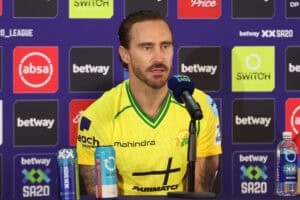It's an undoubted 'perfect storm' as governance implosions take place right next failing on-field systems.

When the Proteas walk onto the field at the Wanderers in the final Test against England on Friday, they’ll be caught between a rock and a hard place.
Should they come unstuck again and concede the series 3-1 to the visitors, a few panic buttons will be pushed.
A victory would see them square the skirmish two-all, but it will only plaster over the cracks.
South African cricket is in undeniable trouble – literally across the board.
Here’s why.
A pronounced lack of depth

Rassie van der Dussen. (Photo by Ashley Vlotman/Gallo Images)
There’s no other way than to come over as disrespecting, but the current Proteas Test side is arguably one of the weakest since re-admission.
To be fair, no international team can be expected to consistently produce world-class exponents, particularly when one has to replace legends such as AB de Villiers, Dale Steyn, Hashim Amla and Morne Morkel.
However, it’s noticeable that the national setup at the moment has to settle for a spine of experienced franchise cricketers who probably lack the highest class.
Rassie van der Dussen, Pieter Malan, Dane Paterson and Dwaine Pretorius are all fighters who know their respective games inside-out.
But they won’t, for example, get into an Australian or India XI … and probably not even in the English one as well.
There are too many solid, unspectacular cricketers keeping domestic cricket afloat instead of potentially great ones.
The Kolpak exodus certainly doesn’t help.
Quotas are harming transformation

Knights opener Grant Mokoena has been around for years. (Photo by Darren Stewart/Gallo Images)
There’s a steady undercurrent of discontent starting to brew under observers regarding the wisdom of Cricket South Africa’s stringent target requirements.
Targets (or quotas, whatever you want to call them) are a useful tool to force coaches and selectors to expose black players to higher levels of competitive action, though that theory is dependent on having enough promising players to pick from in the first place.
Because of government and CSA’s failure to address clogs in the development pipeline, an inadequate number of new black players are being brought into the semi-pro and franchise system.
As a result, franchise cricket has now cultivated a strange system where established black players’ market value has skyrocketed as the teams merely trade them between each other.
You can’t exactly blame them – it’s easier to pay top money for a dependable player than to wait for a new hope to squeeze out of the pipe, especially if you’re under pressure to make up numbers.
There are no fresh faces and, more importantly, no improved competition to keep the veterans on their toes and cultivate rookies.
At the moment, too many black players are being hurt by the label of “quota”.
Lack of intellectual capital

Mali Maketa. (Photo by Lee Warren/Gallo Images)
To be fair, this is an issue that seems to be steadily improving.
Ashwell Prince, Robin Peterson and Imraan Khan are all former Test players who are now forging new paths to becoming successful coaches too.
You can’t place a price on such experience.
Black African coaches such as Wandile Gwavu and Mandla Mashimbyi have now also been afforded the opportunity to build on solid foundations at their franchises and they’ve made their marks.
But a vast treasure trove of knowledge and wisdom lies unused or underappreciated – Dave Nosworthy, Graham Ford, Richard Pybus and Ray Jennings.
Strangely, South African cricket also seems somewhat willing to throw it’s more experienced black coaches on the scrapheap.
Geoff Toyana, who won four franchises trophies, is back coaching in semi-pro cricket, while Mali Maketa was no less than Ottis Gibson’s right-hand man at the Proteas, but was dropped like a hot potato.
Dodgy and uninspired leadership

CSA president Chris Nenzani. (Photo by Johan Rynners/Gallo Images)
Any discerning cricket fan doesn’t need any reminder of how lowly CSA’s current board of directors are regarded.
For that, one just needed to scan through various media releases from various stakeholders – from sponsors to affiliates themselves – all calling for the resignation of all those board members.
How they allowed the corporate governance meltdown at the governing body to reach such a frightening level remains baffling.
Regardless of how the board has performed its fiduciary duties, it has been noticeable in general how CSA (but they aren’t the sole sinners) has struggled to attract effective independent directors.
These individuals were first to resign as suspended CEO Thabang Moroe’s reign crumbled, yet why didn’t they first push back.
It’s possible sporting governing bodies’ independents just wear too many hats to really invest themselves in ensuring smooth governance at the organisations.
And, of course, don’t forget that the endless stream of self-interested “cricket men” continue to infest the non-independent side of things too as CSA’s financial sustainability continues to be eroded.
For more sport your way, download The Citizen’s app for iOS and Android.






